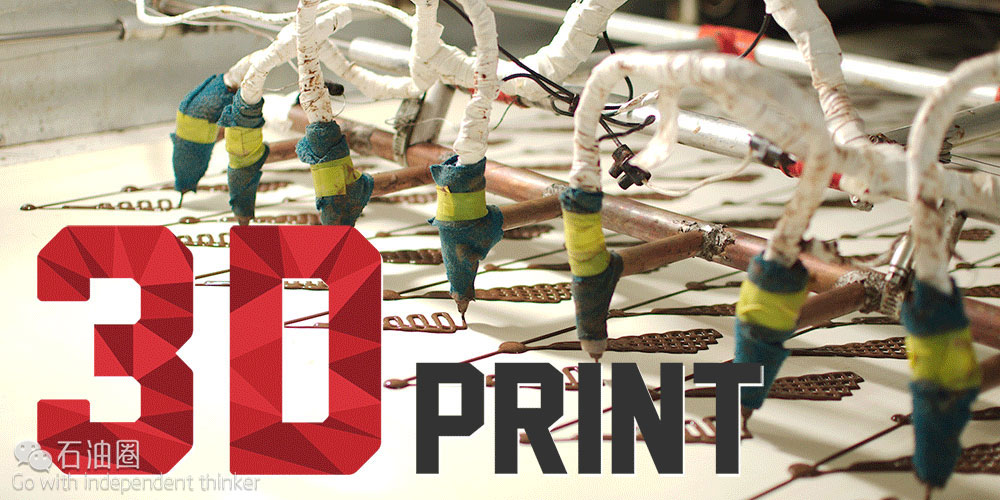
随着3D打印技术的快速发展,油气行业积极将其与传统生产制造、油田服务相结合,逐渐催生增材制造业的发展,其快速成型制造技术可显著减少成本和制造时间,大大改善传统的油田装备制造、油气勘察开发等板块,为油气公司带来更大的利润。尽管目前其合法化和安全化问题还未解决,但我们相信在不久的将来,3D打印技术将会在油气行业有更加广阔的应用前景。
立足企业现代化要求,油气行业积极引进3D打印技术,促进关键领域中常规工作与3D打印技术的深度结合。实践证明,3D打印技术在融合发展过程中表现出色,助推常规生产、一次性生产、小规模生产以及基于现有设计再生产的创新发展,带来更精确、更精简的生产新模式。尽管3D打印技术还不够成熟,其催生的增材制造业无法替代传统制造业,但毫无疑问该技术具有广阔的应用前景。目前3D打印技术的主要用途是快速成型制造技术,与现有的快速成型技术相比,成本和制造时间显著减少。石油圈原创www.oilsns.com
很少有行业能像油气行业一样,包含规模庞大的各类子工业。相关技术以及设备和生产设备制造的进步会不断推进石油和其他燃料的开采和运输,提高采收率,减少资源浪费。3D打印技术出现之后,迅速渗透到行业的方方面面,在新产品进步与发展方面的潜力不可低估,为油气行业带来更多可能。
油气行业中的一些与3D打印相结合的长期项目,预期将会彻底改变关键设备和机械的生产过程。一些公司已经开始将3D打印技术应用在零部件重构、增材制造工艺改进以及即时、定制行业。同时,3D打印技术在油气行业勘察开发板块也发挥着越来越重要的作用,并且有望扩大到油气生产、油气田服务以及原始设备制造(OEM)领域。
在不久的将来,替换件的生产不再需要等待,需要时现场3D打印就可以了。由于标准零件供应不足,或者由于海关和运输延误,现场标准零件常常短缺,如果在现场安装3D打印设备,这个问题就迎刃而解了。另外,现场3D打印技术也可以用于制造新零件供钻探施工使用,满足油气的开采生产过程对设备零件的灵活性和适应性要求。这不仅可以加速油气生产过程,也会最大化避免设备故障或者损坏等问题造成的利益损失,带来数百万美元的潜在利益。也就是说,3D打印可以为油气公司带来更大利益,也为顾客带来更低油价,真正实现企业与顾客的双赢。
然而,3D打印技术在油气行业的全面应用还面临着巨大挑战。由于3D打印技术严重依赖数字信息,在任何技术集成过程中都需要IT团队发挥巨大的作用。IT技术团队不仅需要建立起强大且安全的数字基础设施来管理整个三维数据,而且需要为现场使用搭建数字资产平台,在保证性能和安全的前提下,开发可以充分发挥增材制造设计优势的新产品。石油圈原创www.oilsns.com
另一方面,3D打印技术会引发诸多知识产权问题,在所有会涉及安全和机密问题都得到妥善解决之前,3D打印或许不会应用于计划外项目。针对3D打印零件制造生产的合法安全化问题,相关许可和制造准则还处在初期探索阶段,大部分企业才刚刚开始着手解决这些问题。然而在此之前,他们的知识产权、3D源文件和数据安全没有任何保障,油气公司对3D打印技术的全面普及仍持谨慎态度。石油圈原创www.oilsns.com
高纳德(Gartner)油气上游行业咨询公司研究室主任Morgan Eldred表示,随着3D打印技术商业化,其在未来引发的知识产权问题不容小觑。油气公司以及油服公司都必须做好知识产权保护工作,特别是关键工程领域的知识产权保护。首席信息官(CIO)以及IT人员需要妥善解决知识产权窃取以及伪造问题,确保3D打印零件的高效持久使用,并且与企业架构师、工程师和操作人员之间进行良好的合作交流,这样才能搭建起最佳安全保障系统。
尽管障碍重重,3D打印在油气行业的应用前景依然不可估量,并且有望在未来几年不断扩大。高纳德(Gartner)技术研究公司大胆预测,到2019年,超过10%的油气及油服公司会转变传统制造模式,引进贯穿全产业链的多种3D打印生产技术,开启更为先进的增材制造新模式。
作者/Scott J Grunewald 译者/王文东 编辑/Wang Yue
As with most modern businesses, the Oil and Gas (O&G) industry has begun adopting 3D printing technology into its regular workflow in several key areas. It has proven itself to be a valuable tool for the production of custom, one-off or small run components as well as reworking existing designs to create something more refined and streamlined. While the technology hasn’t advanced to the point where additive manufacturing can replace traditional manufacturing, the industry has found plenty of other uses for the technology. The primary use for the moment seems to be rapid prototyping, which dramatically reduces both cost and turnaround time for developing prototypes.
There are few industries that operate on the sheer scale of the many businesses that make up the O&G industry. The development of related technology and production of equipment and machinery is a constantly evolving process with the goal of harvesting and transporting oil and fuels more efficiently with less waste. The freedom that 3D printing brings to the industry in regards to the advancement and development of new products simply can’t be understated, and it is quickly proliferating every aspect of the business.
Some of the longer-term applications for 3D printing in the O&G industry are expected to completely transform the way that components for a wide range of essential equipment and machinery are produced. Companies have been looking into using 3D printing technology to reconceptualize parts and components, the development of augmented manufacturing processes and instant, on-demand manufacturing. 3D printing is also playing an increasing role in the O&G industry’s research and development activities, and that trend is expected to expand to oil and gas operators, oil field service providers and OEMs.
Soon companies will no longer need to wait for replacement parts but will have the ability to 3D print them on-location when needed. Having 3D printing technology on-site will eliminate long waits in areas where standard parts are going to be in short supply or where shipping and customs clearance issues are likely to delay parts from arriving quickly. On-site 3D printing can also be used to create new parts for use in drilling, where flexibility and adaptability are both important to the successful extraction of oil. Not only will this speed up the process, but it could potentially save millions in lost profits from lost work that can often be attributed to malfunctioning or damaged machinery. That can translate into higher profits for the company, and likely lower oil prices for customers.
Offshore drilling rig in the Gulf of Mexico.
However, there will be some challenges that O&G companies looking to adopt 3D printing technology will need to address. Because 3D printing technologies rely heavily on digital information, IT leaders will need to play an important role in any newly integrated technology. IT staff will need to create a strong and secure digital infrastructure to manage the company’s 3D data. Engineering teams will also have to prepare digital assets for on-site use as well as develop new products that leverage the freedom of designing for additive manufacturing without sacrificing performance or safety.
Until adequate solutions for any potential issues related to the security and confidentiality of intellectual property are found, 3D printing will probably not expand beyond the projected numbers. Licensing and manufacturing guidelines for the legal and safe reproduction of parts manufactured using 3D printing are only in the early stages, and most of the industry leaders are only just beginning to address the issue. Unfortunately, until their intellectual property, 3D files and 3D data can be secured, O&G companies are going to only move cautiously into the adoption of large-scale additive manufacturing.
“With increasing adoption of 3D printing, intellectual property issues will undoubtedly loom large in the future. O&G, as well as oilfield service, companies must enable intellectual property protection, especially within the engineering domains. CIOs and other IT leaders will need to address issues such as preventing intellectual property theft and counterfeiting, ensuring the durability and high performance of 3D-printed parts and enabling collaboration and involvement of enterprise architects with engineering and operations personnel to implement security best practices,” wrote research director for Gartner’s Upstream Oil and Gas Industry Advisory Service Morgan Eldred.
Despite these obstacles, the future of 3D printing technology with the O&G industry is bright, and expected to continue to expand in the next few years. Technology and research company Gartner is even predicting that by 2019 more than ten percent of all O&G companies, including oilfield service providers, will be transitioning from traditional manufacturing methods to more advanced additive manufacturing methods. This shift is expected to be reflected across all of their various operations throughout the industry.
未经允许,不得转载本站任何文章:

 石油圈
石油圈
